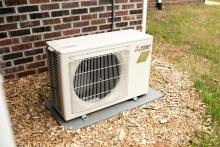Curriculum
-
Remember
View SourcesSources- Remember the principles of heat pump operation, and why some heat pumps need to be made specifically suitable for cold climates.
: Cold Climate Heat Pump Sizing - RememberLecture Notes
: Cold Climate Heat Pumps Sizing - Problem Set 1.1Problem Set
: Cold Climate Heat Pumps Sizing - Problem Set 1.2Problem Set
: Cold Climate Heat Pumps Sizing - Problem Set 1.3Problem Set
-
Understand
- Understand the traditional approach to sizing heat pumps.
- Understand the approaches to sizing heat pumps in cool and cold climates.
- Understand the balance point temperature.
- Understand heat pump cycling.
: Cold Climate Heat Pump Sizing - UnderstandLecture Notes
: Cold Climate Heat Pumps Sizing - Problem Set 2.1Problem Set
: Cold Climate Heat Pumps Sizing - Problem Set 2.2Problem Set
: Cold Climate Heat Pumps Sizing - Problem Set 2.3Problem Set
-
Apply
- Apply energy efficiency improvements to lower cooling and heating loads to allow for a smaller heat pump.
- Apply the steps used to size a cold climate air source heat pump (ccASHP).
- Apply the sizing and selection process for a ccASHP
- Calculate the formula for linear interpolation
- Apply linear interpolation to HVAC equipment sizing
: Cold Climate Heat Pump Sizing - ApplyLecture Notes
: Linear Interpolation - ApplyLecture Notes
: Cold Climate Heat Pumps Sizing - Problem Set 3.1Problem Set
: Cold Climate Heat Pumps Sizing - Problem Set 3.2Problem Set
: Linear Interpolation - Problem Set 3.1Problem Set
Teaching Materials

HVAC Proper Sizing of HVAC Systems
To right-size an HVAC system, you must first accurately determine both the heating and cooling loads. These loads are then used with sizing calculations based on recognized industry standards, such as those developed by the Air Conditioning Contractors of America, or ACAA.
“Rules of thumb” are too often used to size comfort systems, which results in excessively oversized systems. This leads to increased cost, wasted energy, and too-frequent on-and-off cycling, which can compromise comfort and efficiency.
ACCA’s Manual J, Eighth Edition, enables contractors to perform load calculations for homes. Equipment, including ducts, should be selected based on these loads, and the blower capacity must meet the volume of air (cfm) range needed. Note that in the US, the cooling load is often larger than the heating load. Also, the loads in energy-efficient homes are often so small that they fall outside manufacturers’ range of capacities.
